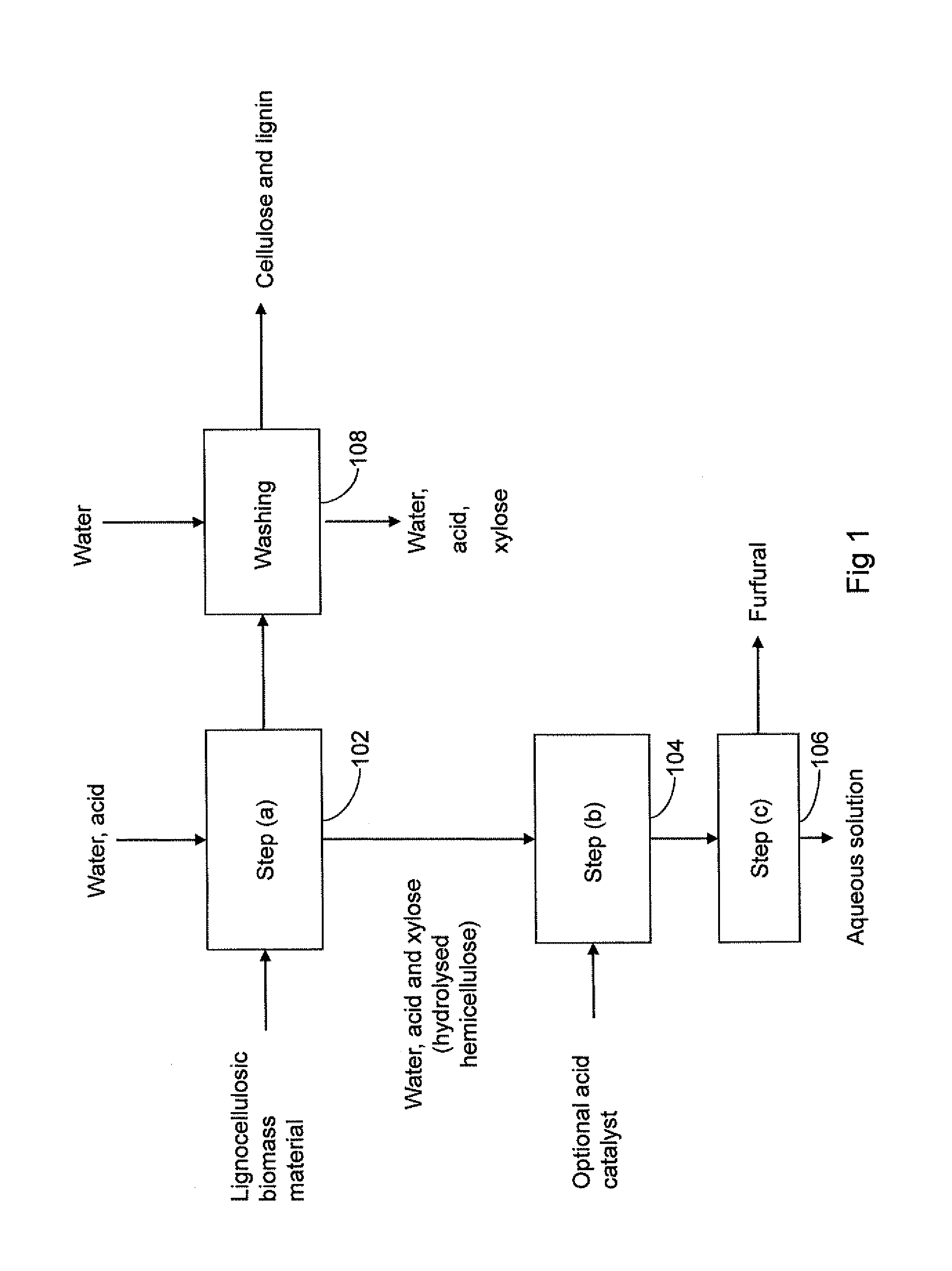Method for producing furfural from lignocellulosic biomass material
a technology of lignocellulosic biomass and furfural, which is applied in the direction of organic chemistry, etc., can solve the problems of complex separation of hemicellulose from other lignocellulosic constituents, ineffective and simple pretreatment process, and inability to meet the requirements of lignocellulosic biomass production, etc.
- Summary
- Abstract
- Description
- Claims
- Application Information
AI Technical Summary
Benefits of technology
Problems solved by technology
Method used
Image
Examples
example 1
Hydrolysis of Birch Wood Chips
[0082]Birch wood sawdust were contacted with an 1 wt % aqueous solution of formic acid in a weight ratio of birch wood to aqeuous solution of 1 to 9.57 at about 155° C. and 5 bar in an 300 cc autoclave during 240 minutes in order to hydrolyse lignocellulose in the birch wood chips.
[0083]The results are illustrated in table 1 below. As illustrated by the total recovered xylose yield in table 1, xylose was obtained in yields up to about 7 wt %. The mixture of xylose and furfural obtained may be less suitable for fermentation due to the presence of furfural but is a very good starting point for the further production of furfural.
example 2
[0084]Bagasse was contacted with an 1 wt % aqueous solution of formic acid in a weight ratio of bagasse to aqeuous solution of 1 to 10 at about 155° C. and 5 bar in an 300 cc autoclave during 3 hours in order to hydrolyse lignocellulose in the bagasse. Hereafter the contents of the autoclave were filtered. The filtrate was recycled for a second round to hydrolyse a second fresh batch of bagasse and the filtrate obtained from the second round was recycled for a third round to hydrolyse a third fresh batch of bagasse. The residues after each filtration were washed with fresh water (in a weight ratio of bagasse to water of 1 to 10). The results are illustrated in tables 2a and 2b below. As illustrated, by recycling the filtrate, xylose yields (not including furfural yield) of more than 3 wt % can readily be obtained. As furthermore illustrated, also acetic acid is removed, making the residual cellulose very suitable for fermentation purposes.
example 3
Furfural Production
[0085]A 5 wt % xylose aqueous solution (representative for a stream of hydrolysed hemicellulose) with 1 wt % formic acid or 0.5 wt % sulphuric acid is introduced in a plug flow reactor and an autoclave, respectively, at 220˜230° C. and 30 bar. The results are illustrated in the tables 3, 4, 5 and 6 given below:
TABLE 1Hydrolysis of birch wood sawdusttotalReactionGlucoseXyloseHMFFurfuralrecoveredLignintimePressureyield **yield **yield **yield **xylose ***yield **(min)(bar)Temp (° C.)wt %wt %wt %wt %wt %wt % 4 *3.70 ± 0.10144.80 ± 1.800.10 ± 0.000.50 ± 0.400.00 ± 0.000.05 ± 0.050.58 ± 0.471.80 ± 0.00 9 *4.20 ± 0.20149.40 ± 0.400.30 ± 0.001.25 ± 1.050.00 ± 0.000.20 ± 0.201.59 ± 1.312.70 ± 0.00 38 *4.55 ± 0.25151.50 ± 0.500.20 ± 0.002.30 ± 1.200.05 ± 0.050.45 ± 0.353.05 ± 1.794.50 ± 0.00122 *5.20 ± 0.00153.55 ± 0.250.40 ± 0.003.35 ± 0.550.10 ± 0.001.20 ± 0.205.22 ± 0.885.40 ± 0.00166 *5.35 ± 0.05154.15 ± 0.450.70 ± 0.003.40 ± 0.000.15 ± 0.052.20 ± 0.206.84 ± 0.347.20 ±...
PUM
| Property | Measurement | Unit |
|---|---|---|
| pressure | aaaaa | aaaaa |
| temperature | aaaaa | aaaaa |
| temperature | aaaaa | aaaaa |
Abstract
Description
Claims
Application Information
 Login to View More
Login to View More - R&D
- Intellectual Property
- Life Sciences
- Materials
- Tech Scout
- Unparalleled Data Quality
- Higher Quality Content
- 60% Fewer Hallucinations
Browse by: Latest US Patents, China's latest patents, Technical Efficacy Thesaurus, Application Domain, Technology Topic, Popular Technical Reports.
© 2025 PatSnap. All rights reserved.Legal|Privacy policy|Modern Slavery Act Transparency Statement|Sitemap|About US| Contact US: help@patsnap.com

